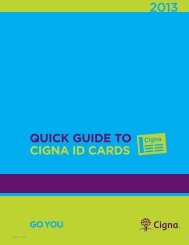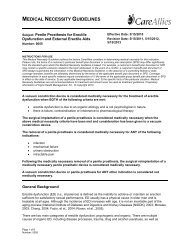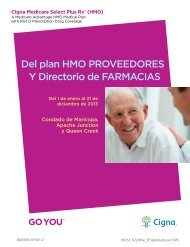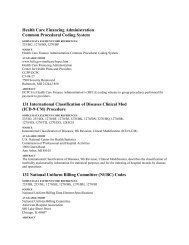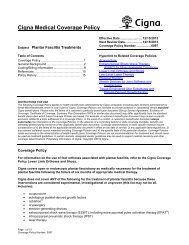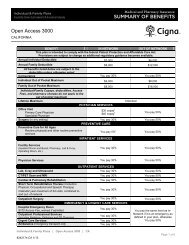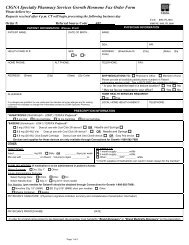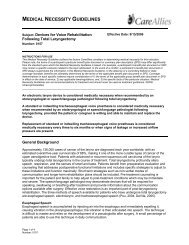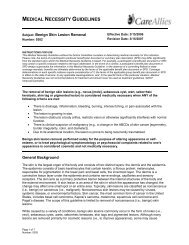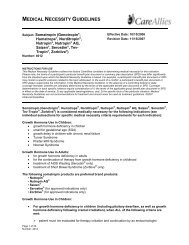Electrical Stimulators - Cigna
Electrical Stimulators - Cigna
Electrical Stimulators - Cigna
You also want an ePaper? Increase the reach of your titles
YUMPU automatically turns print PDFs into web optimized ePapers that Google loves.
suppress spasticity. FES is a high-intensity (25–100 milliamps), short duration therapy that may be delivered for<br />
20 minutes to one hour, several times a week, for months. For the device to be effective, the peripheral nerve<br />
must be intact.<br />
FES is proposed for multiple indications, including:<br />
• to assist ambulation in paraplegics (e.g., Parastep ® I System, Sigmedics, Inc., Fairborn, OH). Parastep<br />
is a microcomputer controlled walker proposed to aid standing, walking, balance and stability in<br />
individuals with a spinal cord injury for whom gait training and standing are indicated. Using surface<br />
electrodes, the device delivers electrical current to peripheral nerves in the lower extremities. Parastep<br />
is a proposed alternative to traditional orthotics and bracing;<br />
• as a means of stationary exercise to prevent or reduce muscle atrophy in upper and lower extremities<br />
(e.g., ERGYS 2; Therapeutic Alliance, Inc., Fairborn, OH). The ERGYS 2 provides cycling activity<br />
proposed to improve muscle strength and circulation in the lower extremities;<br />
• to improve ambulation in patients with gait disorders such as drop foot, hemiplegia due to stroke,<br />
cerebral injury, or incomplete spinal cord injury (e.g., Walkaide stimulator; Neuromotion, Edmonton,<br />
Alberta, Canada; NESS L300 foot drop system, Bioness Inc., Valencia, CA). WalkAide is a device that<br />
attaches to the leg just below the knee and is proposed to counteract foot drop and improve mobility<br />
during walking by stimulating the peroneal nerve. The Ness L300 is a similar device that also attaches<br />
below the knee, provides nerve stimulation and is proposed to assist the individual with foot drop to walk<br />
with increased balance and speed.<br />
• to provide range of motion and function in patients with upper limb paralysis or hemiplegia (NESS H200<br />
hand rehabilitation system [previously known as the Handmaster], Bioness Inc., Valencia, CA). NESS<br />
H200 is for use by an individual with hand paralysis. The device attaches to the lower forearm and is<br />
proposed to activate various muscle groups, enhancing grip and allowing opening and closing of the<br />
hand.<br />
U.S. Food and Drug Administration (FDA): FES devices, such as the Parastep, that have been proposed for<br />
restoring ambulation to paraplegics are regulated by the FDA’s premarket approval (PMA) process.<br />
Functional electrical stimulators that are used to provide stationary exercise for paraplegics, to correct gait<br />
disorders, or to provide range of motion and function are approved by the FDA 510(k) process as Class II<br />
devices. The RT300 FES cycle ergometer (Restorative Therapies, Inc., Baltimore, MD) is approved as a<br />
powered muscle stimulator for “general rehabilitation for relaxation of muscle spasms, prevention or retardation<br />
of disuse atrophy, increasing local blood circulation and maintaining or increasing range of motion” (FDA, 2009).<br />
Other Restorative FES devices include the RT300 Leg, RT300 Leg and Arm, RT300 Arm, RT300 for children.<br />
Literature review<br />
Assist Ambulation in Paraplegics: Studies investigating FES (i.e., Parastep) were published in 2000 or before<br />
and are primarily case series with small patient populations and short-term follow-ups. Brissot et al. (2000)<br />
investigated the motor performances of Parastep in 15 thoracic-spine injured patients (T3-T11). Patients had to<br />
have a stable neurologic and orthopedic status and be at least six months status-post injury and/or restorative<br />
surgery. Two patients did not complete the required training. Follow-up occurred at 40 ± 11 months. After a<br />
mean 20 sessions, the patients achieved independent ambulation with a mean walking distance of 52.8 ± 69<br />
meters (m), and a mean speed of 0.15 6 ± 0.14 m/second. At the final follow-up five patients were using the<br />
Parastep regularly and all patients used it for physical fitness and not for functional ambulation. According to the<br />
authors the high ratio of energy cost of the use of the device may have explained its limited use in daily activity.<br />
The authors also noted that “the Parastep approach has very limited applications for mobility in daily life,<br />
because of its modest performance associated with high metabolic cost and cardiovascular strain. However, it<br />
can be proposed as a resource to keep physical and psychological fitness in patients with spinal cord injury.”<br />
Graupe and Kohn (1998) reported on approximately 400 paraplegic patients with T4-T10 spinal cord injuries that<br />
had used Parastep and successfully achieved standing and at least 30 feet of ambulation using the device.<br />
Gallien et al. (1995) reported on 12 of 13 spinal cord injury (T4-T10) paraplegics who progressed to independent<br />
ambulation with the use of Parastep. Only three patients completed the 32 required training sessions. The<br />
average walking distance was 76 m, with a maximum of 350 m, and the mean speed 0.2 m S-1 . At 15 months<br />
Page 11 of 41



